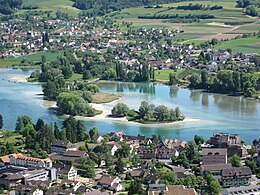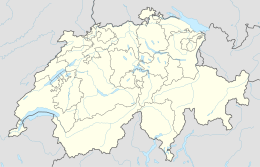Werd (Lake Constance)

Werd archipelago
|
|
| Geography | |
|---|---|
| Location | Situated on lake Untersee (Lake Constance) |
| Coordinates | 47°39′20″N 08°52′00″E / 47.65556°N 8.86667°ECoordinates: 47°39′20″N 08°52′00″E / 47.65556°N 8.86667°E |
| Archipelago | Im Werd (also: Werd Islands) |
| Area | 0.016 km2 (0.0062 sq mi) |
| Length | 0.19 km (0.118 mi) |
| Width | 0.11 km (0.068 mi) |
| Highest elevation | 398 m (1,306 ft) |
| Administration | |
| Canton | Thurgau |
| Municipality | Eschenz |
| Demographics | |
| Population | 9 |
Werd Island is the main island of the small island group Werd Islands in the westernmost part of the Lower Lake of Lake Constance just before the High Rhine leaves the part of the lake known as Rheinsee. It is located on Swiss territory between Stein am Rhein and Eschenz.
The Werd was already inhabited in 5000 BC, using stilt houses. Stone tools used by hunter-gatherers in the Middle Stone Age have been found. In the Neolithic, Werd provided an ideal place to settle. Between 1931 and 1935, the island was excavated under the direction of Karl Keller-Tarnuzzer. Numerous items such as stone axes, arrowheads, a flint sickle, pottery shards, bone fishhooks from the Neolithic and the Bronze Age came to light. Tools, weapons and jewelry from the Bronze Age were found.
Water levels of Lake Constance fell to an extreme low in the winter of 2005/2006. This uncovered a large waterfront areas and some prehistoric artifacts. A selection of prehistoric, Roman Era and medieval artifacts is on display at the entrance of the refectory on the island. Other important finds are now housed in the Museum of Archaeology in Frauenfeld and in the local museum in Eschenz.
In 50 BCE, the Romans built a pile bridge between Rhaetia and Magna Germania via the island. The two bridge sections had a length of 220 and 217 meters and a width of six meters. This Roman road, known in the literature as the Rheatian Boundary Street led from the Vicus Tasgetium (Eschenz) via Rielasingen, Singen, Friedingen, Steißlingen, Orsingen, Vilsingen and Inzigkofen to a ford across the Danube at Laiz. In Orsingen there was a junction to Pfullendorf and Burgweiler. Near Dürren Ast, there was a further junction through the Ablach Valley to Messkirch, Krauchenwies and Mengen-Ennetach.
...
Wikipedia

